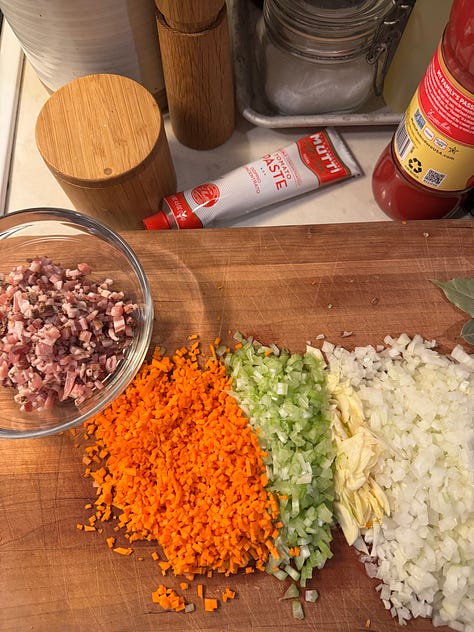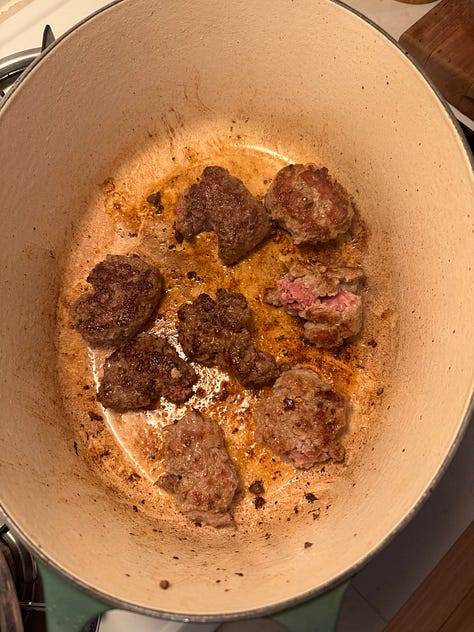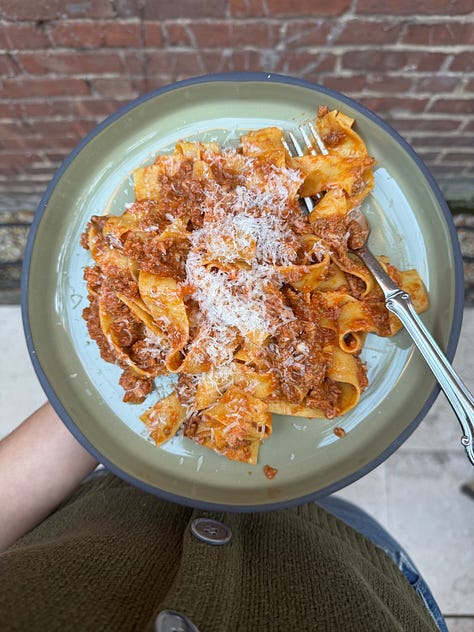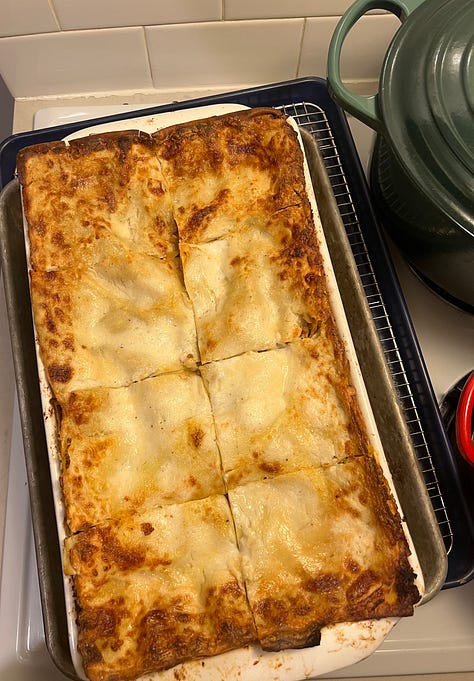Not to be one of those girls who studies abroad in Italy and never shuts up about it, but ever since, when fall gives way to early wintery chill, I can’t help but think back on the few months I was lucky to call Bologna home. It’s been many many moons (nine years, but who’s counting?), and I still have such vivid memories of the streets we walked, the food we ate, the many drinks we had, and the people I got to share it all with.
Bologna is the capital of its region, Emilia Romagna, which is the home of some of Italy’s greatest culinary hits and some of my very favorite things—among them parmigiano, prosciutto, mortadella, tortellini, and of course, the sauce that bears the city’s name: bolognese. In Bologna, it’s just called ragù. It’s ubiquitous and is always found either dressing a tangle of fresh tagliatelle or layered with fresh green pasta sheets and lots of luscious bechamel in a lasagna. I think my seasonal nostalgia is aided by the fact that a lot of Bologna’s cuisine is perfect for the colder months. On a cold night like tonight, don’t you want a fat slice of lasagna bolognese or a big, warming bowl of tortellini in brodo? Maybe after sipping on crisp, bubbly Lambrusco and snacking on some fried bread called crescentine with prosciutto?
I count myself especially lucky that I got to share Bologna with some American friends who were as excited to take in the city’s culinary offerings as I was. Together, we cooked in the tiny apartments we shared with Italian students. We meandered the burnt-orange, portico-covered streets in search of the coziest osteria, where we would devour bowls of tagliatelle, washed down with carafes of unreasonably cheap Sangiovese. We shared countless platters of paper-thin mortadella, which we often piled high on another regional bread, pan griddled tigelle, with tart, creamy squacquerone cheese. Once we ventured to a cheese store where a shopkeeper challenged us to taste the difference between the 18-month, 24-month and 5-year aged Parmigiano Reggiano; I still remember how the pungently sweet crystals of the 5 year old cheese lingered in my mouth and the ripe, funky smell of the shop lingered in my hair for hours—heaven. We traveled to the home of an eccentric elderly woman, who taught us how to roll and shape tortelli and practically kept us prisoner in her home until midnight. We ate thin piadina sandwiches at lunch and frequented arty student cafes in the afternoons, where we drank spritz and ate cheap aperitivo and stumbled our way through Italian novels. We attempted to learn how to roll cigarettes and had lots of gelato and drank too much coffee.
All this to say, Bologna’s cuisine left a mark on me, introducing me to many foods, but reinforcing my love for one in particular: ragù bolognese. As such, the first cool days of November or December require that I make a batch. I have made it countless times over the years, for family, for friends, for occasions good and bad. It’s an expression of love, a source of comfort, and a damn good meal.
Bolognese is a kitchen project that requires a little attention and care, but not a ton of skill or hands-on time. Most of the magic happens as the sauce simmers and reduces and the ingredients melt and meld for hours. This is one of the rare occasions that I think chopping your vegetables very finely is important, so take your time. I find this task to be part of the gratifying experience of making something special, but you can definitely finely chop the pancetta and vegetables in a food processor (and I really mean that with zero Barefoot-Contessa-“storebought-is-fine” judgment). Just be sure to work in batches and pulse gently to avoid forming a paste or puree.
Every step at the beginning of this recipe is key to building flavor, but the one I feel most strongly about is browning the meat. Don’t try to get it all browned—you want some caramelization, but browning all of it will take forever and will dry out your meat. All you really want is to achieve a few deeply caramelized surfaces and to get it out of the pot quickly. You’ll be left with a bowl of semi-browned, semi-raw meat, which is kind of gross, but trust the process. Do be sure to exercise some patience when cooking down that soffritto (the Italian term for the classic onion-carrot-celery trio)—you want it to become super soft and golden.



An important, if tedious disclaimer: I do not claim that this is the traditional way to make bolognese, or that it is at all original. It’s just a version I’ve amalgamated and come to love over the years. One of the biggest differences between ragù in Bologna and bolognese that you usually come across in America is the quantity of tomato—and it’s something I flip flop on too. Sometimes I love the tangy brightness that the canned tomatoes add, and sometimes I just want a more traditional, meat-forward, more savory ragù. You’ll see in my recipe that the inclusion of canned tomato and the amount is up to you—maybe you’ll make this sauce for years to come and you’ll find your ideal version.



Ragù Bolognese
This recipe yields a lot of sauce, but it freezes well and is such a gift to have on hand. Serve it on al dente pasta—a fresh, wide noodle like tagliatelle or pappardelle is nice here, or a dried tube like rigatoni or paccheri, or whatever you like (just not spaghetti). Bring the sauce and the pasta together in the pot with a splash of pasta water and be sure to serve with lots of parm.
Serves 6 to 10
1 tablespoon extra-virgin olive oil
1 pound ground beef
1 pound ground pork
Kosher salt and freshly ground black pepper
3 to 4 ounces pancetta, finely chopped
1 yellow onion, finely diced
1 medium carrot, finely diced
1 stalk celery, finely diced
3 garlic cloves, thinly sliced or finely chopped
1/4 cup tomato paste
1 cup dry white wine
1 28-ounce can whole peeled tomatoes, crushed by hand or 1 24-ounce bottle tomato passata*
2 cups chicken stock
1 1/2 cups whole milk
A few bay leaves (fresh, if you have them)
1 parmigiano rind
*Or use half of that amount, or none at all! If you opt to omit the canned tomato entirely, you can add an extra 1/2 cup of both wine and stock.
Preheat a large, heavy bottomed pot or Dutch oven over high heat. Add the oil; when it shimmers; break some of the meat into large clumps and carefully place them into the pot, taking care not to overcrowd the pan. Season the meat generously with salt and pepper. Once the meat is well browned and caramelized, flip it and brown it on the other side. Transfer the browned meat to a bowl and repeat with the remaining meat.
Lower the heat to medium low. Add the pancetta and cook, stirring frequently, until the fat is rendered and the pancetta pieces are lightly golden, about 5 minutes. Add the onion, celery, carrot, and garlic. Season with salt and pepper, raise the heat to medium, and cover the pot (this will help jumpstart the process of softening the veggies) for 5 minutes. Uncover and sauté, stirring occasionally and scraping up any remaining browned bits of meat or pancetta, until super soft and light golden brown, another 10 minutes or so. Add the tomato paste and cook, stirring, until it has darkened to a brick color and is beginning to stick to the bottom of the pot.
Return the meat to the pot, add the wine, and use a wooden spoon to break the meat up into small pieces while the wine reduces. Once the wine has all been absorbed and the meat is well crumbled, add the canned tomato, if using, the chicken stock, milk, bay leaves, and parm rind. Bring to a gentle boil, lower to a bare simmer and cook, stirring occasionally, for at least 2 and as long as 4 hours. (Alternatively, cover the pot with the lid slightly ajar and place in a 250°F oven for 3 to 4 hours. I like this method because it’s easier to maintain a gentle, even cook. Just make sure to stir the sauce every hour or so and check that it is still simmering gently; adjust the oven temperature as needed.) You’ll know the ragù is done when it looks thick and luscious and emulsified and the meat is super tender and flavorful. If the sauce gets too thick before you reach that point, add a splash of water as needed. Taste and season with more salt if it needs it.
Happy bolognese season, and from the bottom of my heart, grazie mille for reading!!!
xx,
Megan





One my absolute favorites!!